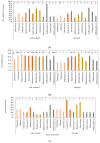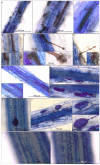Growth and Photosynthetic Activity of Selected Spelt Varieties (Triticum aestivum ssp. spelta L.) Cultivated under Drought Conditions with Different Endophytic Core Microbiomes
- PMID: 33121138
- PMCID: PMC7662716
- DOI: 10.3390/ijms21217987
Growth and Photosynthetic Activity of Selected Spelt Varieties (Triticum aestivum ssp. spelta L.) Cultivated under Drought Conditions with Different Endophytic Core Microbiomes
Abstract
The role of the microbiome in the root zone is critically important for plants. However, the mechanism by which plants can adapt to environmental constraints, especially water deficit, has not been fully investigated to date, while the endophytic core microbiome of the roots of spelt (Triticum aestivum ssp. spelta L.) grown under drought conditions has received little attention. In this study, we hypothesize that differences in the endophytic core of spelt and common wheat root microbiomes can explain the variations in the growth and photosynthetic activity of those plants, especially under drought conditions. Our greenhouse experimental design was completely randomized in a 2 × 4 × 3 factorial scheme: two water regime levels (well-watered and drought), three spelt varieties (T. aestivum ssp. spelta L.: 'Badenstern', 'Badenkrone' and 'Zollernspelz' and one wheat variety: T. aestivum ssp. vulgare L: 'Dakotana') and three mycorrhizal levels (autoclaved soil inoculation with Rhizophagus irregularis, control (autoclaved soil) and natural inoculation (non-autoclaved soil-microorganisms from the field). During the imposed stress period, relative water content (RWC), leaf chlorophyll fluorescence, gas exchange and water use efficiency (WUE) were measured. Microscopic observations of the root surface through fungi isolation and identification were conducted. Our results indicate that 'Badenstern' was the most drought tolerant variety, followed by 'Zollernspelz' and 'Badenkrone,' while the common wheat variety 'Dakotana' was the most drought sensitive. Inoculation of 'Badenstern' with the mycorrhizal fungi R. irregularis contributed to better growth performance as evidenced by increased whole plant and stalk dry matter accumulation, as well as greater root length and volume. Inoculation of 'Zollernspelz' with arbuscular mycorrhizal fungi (AMF) enhanced the photochemical efficiency of Photosystem II and significantly improved root growth under drought conditions, which was confirmed by enhanced aboveground biomass, root dry weight and length. This study provides evidence that AMF have the potential to be beneficial for plant growth and dry matter accumulation in spelt varieties grown under drought conditions.
Keywords: abiotic stress; arbuscular mycorrhizal (AM); chlorophyll fluorescence; fungal diversity; photosynthesis.
Conflict of interest statement
The authors declare no conflict of interest.
Figures
















Similar articles
-
Changes in root-associated fungal communities in Triticum aestivum ssp. spelta L. and Triticum aestivum ssp. vulgare L. under drought stress and in various soil processing.PLoS One. 2020 Oct 6;15(10):e0240037. doi: 10.1371/journal.pone.0240037. eCollection 2020. PLoS One. 2020. PMID: 33021992 Free PMC article.
-
Arbuscular Mycorrhizal fungi (AMF) protects photosynthetic apparatus of wheat under drought stress.Photosynth Res. 2019 Mar;139(1-3):227-238. doi: 10.1007/s11120-018-0538-4. Epub 2018 Jul 7. Photosynth Res. 2019. PMID: 29982909
-
Field response of wheat to arbuscular mycorrhizal fungi and drought stress.Mycorrhiza. 2004 Aug;14(4):263-9. doi: 10.1007/s00572-003-0265-2. Epub 2003 Aug 26. Mycorrhiza. 2004. PMID: 12942358
-
The role of arbuscular mycorrhizal symbiosis in improving plant water status under drought.J Exp Bot. 2023 Sep 2;74(16):4808-4824. doi: 10.1093/jxb/erad249. J Exp Bot. 2023. PMID: 37409696 Review.
-
Unravelling the role of arbuscular mycorrhizal fungi in mitigating the oxidative burst of plants under drought stress.Plant Biol (Stuttg). 2021 May;23 Suppl 1:50-57. doi: 10.1111/plb.13161. Epub 2020 Oct 12. Plant Biol (Stuttg). 2021. PMID: 32745347 Review.
Cited by
-
Environmental interference of plant-microbe interactions.Plant Cell Environ. 2022 Dec;45(12):3387-3398. doi: 10.1111/pce.14455. Epub 2022 Oct 12. Plant Cell Environ. 2022. PMID: 36180415 Free PMC article. Review.
-
Environmental Stress and Plants.Int J Mol Sci. 2022 May 12;23(10):5416. doi: 10.3390/ijms23105416. Int J Mol Sci. 2022. PMID: 35628224 Free PMC article.
-
Impact of the Cultivation System and Plant Cultivar on Arbuscular Mycorrhizal Fungi of Spelt (Triticum aestivum ssp. Spelta L.) in a Short-Term Monoculture.Pathogens. 2022 Jul 28;11(8):844. doi: 10.3390/pathogens11080844. Pathogens. 2022. PMID: 36014965 Free PMC article.
References
-
- Pontonio E., Dingeo C., Di Cagno R., Blandino M., Gobbetti M., Rizzello C.G. Brans from hull-less barley, emmer and pigmented wheat varieties: From by-products to bread nutritional improvers using selected lactic acid bacteria and xylanase. Int. J. Food Microbiol. 2020;313:108384. doi: 10.1016/j.ijfoodmicro.2019.108384. - DOI - PubMed
-
- Verma P., Suman A. Wheat microbiomes: Ecological significances, molecular diversity and potential bioresources for sustainable agriculture. EC Microbiol. 2018;14:641–665.
-
- Shewry P.R., Hey S.J. Do “ancient” wheat species differ from modern bread wheat in their contents of bioactive components? J. Cereal Sci. 2015;65:236–243. doi: 10.1016/j.jcs.2015.07.014. - DOI
-
- Andruszczak S., Kwiecińska-Poppe E., Kraska P., Pałys E. Yield of wintercultivars of spelt wheat (Triticum aestivum ssp. spelta l.) cultivated under diversified conditions of mineral fertilization and chemical protection. Acta Sci. Pol. Agric. 2011;10:5–14.
MeSH terms
Substances
Supplementary concepts
LinkOut - more resources
Full Text Sources
Medical

